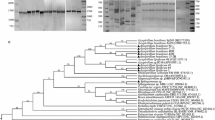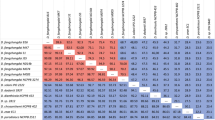Abstract
Interest in species of the genus Penicillium is related to their ability to produce the mycotoxin patulin and to cause spoilage of fruit products worldwide. The sequence of the isoepoxydon dehydrogenase (idh) gene, a gene in the patulin biosynthetic pathway, was determined for 28 strains representing 12 different Penicillium species known to produce the mycotoxin patulin. Isolates of Penicillium carneum, Penicillium clavigerum, Penicillium concentricum, Penicillium coprobium, Penicillium dipodomyicola, Penicillium expansum, Penicillium gladioli, Penicillium glandicola, Penicillium griseofulvum, Penicillium paneum, Penicillium sclerotigenum and Penicillium vulpinum were compared. Primer pairs for DNA amplification and sequencing were designed from the P. griseofulvum idh gene (GenBank AF006680). The two introns present were removed from the nucleotide sequences, which were translated to produce the IDH sequences of the 12 species for comparison. Phylogenetic relationships among the species were determined from rDNA (ITS1, 5.8 S, ITS2 and partial sequence of 28S rDNA) and from the idh nucleotide sequences minus the two introns. Maximum parsimony analysis showed trees based on rDNA and idh sequences to be congruent. It is anticipated that the genetic information obtained in the present study will aid in the design of probes, specific for patulin biosynthetic pathway genes, to identify the presence of these mycotoxigenic fungi.





Similar content being viewed by others
References
Beck J, Ripka S, Siegner A, Schiltz E, Schweizer E (1990) The multifunctional 6-methylsalicylic acid synthase gene of Penicillium patulum. Its gene structure relative to that of other polyketide synthases. Eur J Biochem 192:487–498
Boysen M, Skouboe P, Frisvad JC, Rossen L (1996) Reclassification of the Penicillium roqueforti group into three species on the basis of molecular genetic and biochemical profiles. Microbiology 142:541–549
Dombrink-Kurtzman MA (2006) The isoepoxydon dehydrogenase gene of the patulin metabolic pathway differs for Penicillium griseofulvum and Penicillium expansum. Anton van Leeuw 89:1–8
Dombrink-Kurtzman MA, Blackburn JA (2005) Evaluation of several cultural media for production of patulin by Penicillium species. Int J Food Microbiol 98:241–248
Dombrink-Kurtzman MA, Engberg AE (2006) Byssochlamys nivea with patulin producing capability has an isoepoxydon dehydrogenase gene (idh) with sequence homology to Penicillium expansum and P. griseofulvum. Mycol Res 110:1111–1118
Fedeshko RW (1992) Polyketide enzymes and genes in Penicillium urticae. Ph.D. Dissertation, University of Calgary, Calgary, Alberta, Canada
Frisvad JC, Filtenborg O (1983) Classification of terverticillate penicillia based on profiles of mycotoxins and other secondary metabolites. Appl Environ Microbiol 46:1301–1310
Frisvad JC, Filtenborg O (1989) Terverticillate penicillia: chemotaxonomy and mycotoxin production. Mycologia 81:837–861
Frisvad JC, Samson RA (2004) Polyphasic taxonomy of Penicillium subspecies Penicillium. A guide to identification of food and air-borne terverticillate Penicillia and their mycotoxins. Stud Mycol 49:1–174
Frisvad JC, Thrane U (1987) Standardized high-performance liquid chromatography of 182 mycotoxins and other fungal metabolites based on alkylphenone retention indices and UV–VIS spectra (diode array detection). J Chromatogr 404:195–214
Frisvad JC, Filtenborg O, Wicklow DT (1987) Terverticillate Penicillia isolated from underground seed caches and cheek pouches of banner-tailed kangaroo rats (Dipodomys spectabilis). Can J Bot 65:765–773
Frisvad JC, Smedsgaard J, Larsen TO, Samson RA (2004) Mycotoxins, drugs and other extrolites produced by species in Penicillium subgenus Penicillium. Stud Mycol 49:201–242
Leistner L, Eckardt C (1979) Vorkommen toxinogener Penicillien bei Fleischerzeugnissen. Fleischwirtschaft 59:1892–1896
Paterson RRM, Archer S, Kozakiewicz Z, Lea A, Locke T, O’Grady E (2000) A gene probe for the patulin metabolic pathway with potential for use in patulin and novel disease control. Biocontrol Sci Technol 10:509–512
Paterson RRM, Kozakiewicz Z, Locke T, Brayford D, Jones SCB (2003) Novel use of the isoepoxydon dehydrogenase gene probe of the patulin metabolic pathway and chromatography to test penicillia isolated from apple production systems for the potential to contaminate apple juice with patulin. Food Microbiol 20:359–364
Peterson SW (2000) Phylogenetic analysis of Penicillium species based on ITS and LSU-rDNA nucleotide sequences. In: Samson RA, Pitt JI (eds) Integration of modern taxonomic methods for Penicillium and Aspergillus classification. Harwood Academic Publishers, Amsterdam, pp 163–178
Scrutton NS, Berry A, Perham RN (1990) Redesign of the coenzyme specificity of a dehydrogenase by protein engineering. Nature 343:38–43
Sekiguchi J, Gaucher GM (1978) Identification of phyllostine as an intermediate of the patulin pathway in Penicillium urticae. Biochemistry 19:1785–1791
Sekiguchi J, Gaucher GM (1979) Isoepoxydon, a new metabolite of the patulin pathway in Penicillium urticae. Biochem J 182:445–453
Sekiguchi J, Shimamoto T, Yamada Y, Gaucher GM (1983) Patulin biosynthesis: enzymatic and nonenzymatic transformations of the mycotoxin (E)-ascladiol. Appl Environ Microbiol 45:1939–1942
Svendsen A, Frisvad JC (1994) A chemotaxonomic study of the terverticillate Penicillia based on high performance liquid chromatography of secondary metabolites. Mycol Res 98:1317–1328
Swofford DL (1998) PAUP* 4.0: phylogenetic analysis using parsimony (and other methods). Sinauer Associates, Sunderland, MA, USA
White S, O’ Callaghan J, Dobson ADW (2006) Cloning and molecular characterization of Penicillium expansum genes upregulated under conditions permissive for patulin biosynthesis. FEMS Microbiol Lett 255:17–26
Acknowledgements
Special thanks are given to Amy E. Engberg for excellent technical assistance and to Dr. Cletus P. Kurtzman for generation of phylogenetic trees. Names of equipment and chemical supplies are necessary to report factually on experimental methods; however, the USDA neither guarantees nor warrants the standard of the products, and the use of the name by USDA implies no approval of the products to the exclusion of others that may also be suitable.
Author information
Authors and Affiliations
Corresponding author
Additional information
The U.S. Government's right to retain a non-exclusive, royalty-free license in and to any copyright is acknowledged.
Rights and permissions
About this article
Cite this article
Dombrink-Kurtzman, M.A. The sequence of the isoepoxydon dehydrogenase gene of the patulin biosynthetic pathway in Penicillium species. Antonie van Leeuwenhoek 91, 179–189 (2007). https://doi.org/10.1007/s10482-006-9109-3
Received:
Accepted:
Published:
Issue Date:
DOI: https://doi.org/10.1007/s10482-006-9109-3




